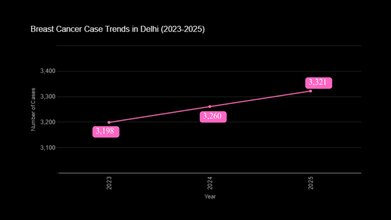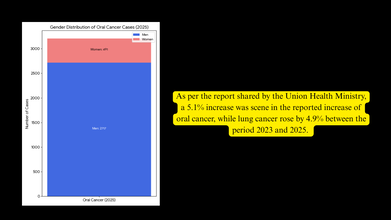- Health Conditions A-Z
- Health & Wellness
- Nutrition
- Fitness
- Health News
- Ayurveda
- Videos
- Medicine A-Z
- Parenting
Woman Left Screaming In Pain After Sex Toy 'Pulled Through Body' During MRI Scan

MRI scans are strong diagnostics with high-definition images of what lies inside a body. Strong magnetic fields require precaution, as brought out by an instance where a young woman suffered very serious injuries due to an oversight in a metallic core within a silicone sex toy that she happened to have before the MRI scan. This makes a stark reminder about the potentially deadly consequences of missing metal objects when such procedures are being performed. In April 2023, a 23-year-old woman went into an MRI with a silicone plug containing a metal core that was not known.
She thought that the item is made entirely out of silicone according to the advertising. However, the strong magnetic field of the MRI machine interacted with the hidden metal, dragging the object through her body and causing excruciating pain. According to reports from the U.S. Food and Drug Administration (FDA), the scene was harrowing, with the woman screaming in agony and requiring immediate hospitalization. Despite pre-scan screenings, which are routine prior to a scan, the patient did not inform the facility that the object existed because he presumed it was purely non-metallic. This caused serious injuries that led to the patient's law suit against the manufacturer for deceitful misrepresentations of material content.
MRI machines employ magnets between 0.5 to 3 Tesla (T). This is thousands of times stronger than the Earth's magnetic field. The tremendous force causes ferromagnetic materials, like iron and nickel, to be magnetized quickly and become strongly attracted toward the magnet. Objects as small as hairpins or paper clips will accelerate at 40 miles per hour inside the magnetic field.
The force can lead to catastrophic injuries in items lodged within the body, such as metallic implants or foreign objects. Metallic cores within devices, like pacemakers or intrauterine devices, must be disclosed to radiologists to prevent such complications.
How Metal Objects Interact with MRI Fields?
On these claims, Dr. Adam Taylor, a specialist in human anatomy, weighed his words in a international health website and added that the distance away and mass of this object would increase its velocity towards that of sound, "The acceleration would be phenomenal, but with a metallic core, it can't go anywhere near supersonic speeds. As for the size, the magnetic acceleration to the internal soft tissues would ensure that there could be severe intracranial trauma."
The injuries inflicted in this case likely involved damage to major blood vessels, nerves, or organs, highlighting the devastating impact of even minor oversight during an MRI scan.
This is not an isolated case. There are documented cases of metallic objects causing serious damage during MRI scans with a 65-year-old man with schizophrenia swallowed metal objects, including sockets and a hinge pin. The powerful magnetic field during an MRI scan caused the objects to rupture his stomach, resulting in serious injuries.
A toddler who ingested 11 small magnets perforated his bowel while undergoing a scan, making his case unique. In another deadly but extremely rare incident, there have been people who hide a firearm on themselves during MRI procedures. Magnetic attraction can trigger a discharge in a weapon and has led to some fatal injuries.
These cases emphasize the very strong need for adequate screening and patient education prior to an MRI.
Preventing MRI-Related Incidents
Medical professionals have been trained to avoid risks. This is by properly screening a patient for metallic objects. In general, most pre-scan protocols include:
- Patients are interrogated about implants, recent surgery or exposures at work related to metals.
- Radiologists sometimes use handheld metal detectors to search for hidden items.
- People who work with metal, like welders or machinists, will need additional testing to detect microscopic metal fragments within soft tissues or eyes.
The case emphasizes the importance of product labeling by manufacturers, especially those products that are likely to unintentionally cause harm to health. The patient's assumption that her device was 100% silicone points to a larger problem in consumer markets with misinformation.
It also reminds the patients to report any possible dangers to the medical professionals, no matter how the objects look non-metallic. In sensitive cases, patients can request private discussions with healthcare providers to ensure safety without discomfort.
In the end, it is a joint effort from manufacturers, healthcare professionals, and patients that can prevent such tragedies. Manufacturers must ensure truthful marketing, while healthcare providers should educate patients about the dangers of metal objects in MRI settings. For patients, understanding the risks and actively participating in pre-scan disclosures can be lifesaving.
This young woman's experience is a sobering example of the unforeseen dangers posed by MRI machines when precautions are overlooked. It serves as a wake-up call to address gaps in patient awareness, medical protocols, and product transparency. By learning from this incident, the medical community and the public can work together to ensure MRI scans remain a safe and effective diagnostic tool.
Delhi Sees Rising Cancer Burden With Sharp Increase in Oral and Lung Cancers; Breast Cancer Remains Most Common

Credits: iStock and Canva
Oral cancer cases recorded the sharpest in Delhi in 2025, as per the Union Health Ministry data presented in the Parliament. While there is no definitive explanation provided by the report by the Union Health Ministry, previous reports show that widespread use of tobacco has increased, and accounted for about 30% of all oral cancer cases in India alone.

As per the report shared by the Union Health Ministry, a 5.1% increase was scene in the reported increase of oral cancer, while lung cancer rose by 4.9% between the period 2023 and 2025.

The data showed that lung cancer increased among women, and it rose to 6.5%. In numbers, this would make 686 cases in 2025, which is up from the 644 cases recorded in 2024, and 604 in 2023. Among men, oral cancer had the highest growth, with a 5.8% increase. This led to 2,717 cases in 2025, compared to 2,569 cases in 2024 and 2,429 cases in 2023.

However, breast cancer remained the most prevalent cancer in the city. Data from the National Cancer Registry Programme indicate a steady rise in reported breast cancer cases, increasing from 3,198 in 2023 to 3,260 in 2024 and 3,321 in 2025. Oral cancer ranked as the second most common cancer overall, with combined cases among men and women reaching 3,208 in 2025.

A closer look at the data shows that oral cancer continued to rise in the city over the past three years. In 2023, Delhi reported 2,901 cases, including 2,429 among men and 472 among women. The number rose to 3,051 cases in 2024, with 2,569 cases in men and 482 in women. Among women, cases increased slightly further to 491 in 2025.
The International Journal of Research in Medical Sciences provide the tobacco use, betel quid chewing has seen a rising trend in India. Tobacco use includes chewing gutka and khaini in rural areas as well as smoking cigarettes in urban area, which continues to be the nation's leading preventable cause of cancer.
Cervical Cancer Shows a Decline
Cervical cancer followed a different pattern. Cases among women fell from 741 in 2023 to 716 in 2024, and then to 692 in 2025. This reflects a year-on-year decline of around 3.4 percent over both periods.
Rising Trends in Other Cancers Among Men
Among men, oral cancer showed the sharpest increase. Lung cancer cases also rose, climbing from 1,668 in 2023 to 1,814 in 2025. Prostate cancer followed a similar upward trend, with reported cases increasing from 1,168 in 2023 to 1,301 in 2025.
Delhi’s High Cancer Incidence Rate
The health ministry has pointed to Delhi’s relatively high Age-Adjusted Incidence Rate of cancer. Between 2015 and 2019, the AAIR stood at 146.7 per one lakh population among men and 132.5 among women. These figures are higher than those reported in cities such as Mumbai, Kolkata, Pune and Ahmedabad. The AAIR allows cancer rates to be compared fairly across regions with different age profiles.
Treatment Burden Extends Beyond Delhi
It is also important to note that Delhi attracts a large number of cancer patients from across north India and other parts of the country. Major tertiary care centres, including AIIMS and the Rajiv Gandhi Cancer Institute and Research Centre, contribute to a higher treatment load in the city.
Measles Warning: 'Be Careful, Holidays Worry Us', Says Doctor

Credits: iStock
Rougeole/Measles: Christmas is not even 10 days away and other festivities are also lining up. With the holiday season coming in, more cases of measles are likely to be added to the five which had already been recorded in Montreal.
"It's certain that the holiday season worries us, because we gather, we meet our families, we have more contact, and therefore more opportunities for transmission of the virus," said Dr. Paul Le Guerrier on QUB radio and television, broadcast simultaneously on 99.5 FM Montreal, Tuesday.
As per the medical advisor at Montreal's Regional Public Health Department, a surge in cases during this time of the year is conducive as there will be more gathering. In fact, "almost 95% of population would need to be vaccinated to prevent community transmission."
"At the end of secondary school, we reach levels of 86-88%. But we are not yet at the desired threshold," the doctor specifies.
Can Measles Be Prevented?
The spread could be curbed and a significant outbreak during the holiday season could be avoided, if vaccination is done in full flow. Public health department has sent letters to all schools in Montreal province. "If children do not have two doses of measles vaccine, [they are encouraged] to make an appointment or go see their family doctor to increase their vaccination coverage," explained Dr. Le Guerrier.
The public is also urged to keep a check of common signs and measles symptoms like:
- Fever
- Nasal congestion with runny nose
- Cough
- Conjunctivitis
- Eyes sensitive to light
- Widespread unease
Measles In Canada
The Global News reported that so far, Quebec has confirmed three measles cases linked to pediatric medical center in an off-island suburb of Montreal.
The first case was identified in early December, marking the province’s first measles infection since April. Health officials say people who visited the UP pediatric emergency centre in St-Eustache, Que., on the afternoon or evening of Nov. 28 may have been exposed.
So far this year, Canada has reported more than 5,300 measles cases, largely in Ontario and Alberta. Quebec recorded 36 cases during an earlier outbreak. The provincial government warns additional cases are likely and stresses vaccination as the strongest protection against the highly contagious disease.
Unique Symptoms Of Measles To Look Out For
Measles has a high transmissibility, and high measles immunity levels are required to prevent sustained measles virus transmission. This is why herd immunity for measles could be easily breached.
It easily spreads from one infected person to another through breathes, coughs or sneezes and could cause severe disease, complications, and even death.
Read: Unique Symptoms Of Measles In 2025 And How Long Does The Infection Last?
The most unique symptom or the early sign of measles in the Koplik spots. These are tiny white dots that look like grains of salt on red gums inside the cheeks that appear before the red rash starts to appear on a person's face and then the body.
Furthermore, the symptoms of measles are also characterized by the three Cs:
- Cough
- Coryza or runny nose
- Conjunctivitis or red and water eyes
The progression of the symptom comes in two stages, first is the prodromal stage or Days 1 to 4, where one would notice high fever, cough, runny nose, red and watery eyes, sore throat, fatigue, and Koplik spots.
The second stage is called the rash stage or the days 5 to 10 or even more where rash start to appear on the hairline, and then it runs down the body. It lasts for several days and fades in the same order.
The first symptoms, notes the Centers for Disease Control and Prevention (CDC), appear 7 to 14 days after a measles infection. Often, it could also lead to ear infection, or even diarrhea. Though these complications happen in every 1 in 10 children or individual with measles.
Angelina Jolie Shows Her Mastectomy Scars, Turns Survival, Choice, and Breast Cancer Awareness Into a Powerful Statement

Credits: iStock and Wikimedia Commons
Angelina Jolie, in an act of bravery, for what many women are often shamed, has revealed her mastectomy scars in a magazine photo shoot for Time France. Now 50, she said she chose to show the result of her preventative breast cancer operation because she was "moved" when other women shared their scars.
Jolie during the cover shoot of Time France said, "I share these scars with many women I love, and I am always moved when I see other women share theirs. I wanted to join them, knowing that Time France would be sharing information about breast health, prevention, and knowledge about breast cancer."
Angelia Jolie's Mastectomy Scars
The 50-year-old actress had a double mastectomy at the age of 37 in 2013. This was after she had discovered that she carried a faulty copy of BRCA1 gene, which had put her in the risk of cancer. The disease runs in her family, as her mother too died of ovarian cancer aged 56 in 2007. She had lost her grandmother and aunt to the same disease.
Now, the Oscar-winning actress has posed showing her double mastectomy scars for the first time so she could raise awareness. The cover photo could be seen with her wearing a low-cut sweater that reveals her scars on the cover photo. The magazine issue that will be published on December 18 will feature a full interview with more photos of her operation scars.
Back in 2015, she revealed in The New York Times article that she also had her ovaries and fallopian tubes removed as a preventative measure against developing cancer. She wrote that she had been planning this for "some time now" and that her "children will never have to say, 'Mom died of ovarian cancer'."
According to Cancer Research UK, around 7,600 women are diagnosed with ovarian cancer each year in the UK, and about 4,100 die from it. The disease often shows few or no symptoms until later stages. Jolie, a mother of six, has long advocated awareness due to her family history, urging women to seek medical advice, stressing that knowledge empowers.
Also Read: More Than A Diagnosis: Cancer Survivors Share The Small Wins That Helped Them Heal
What is the BRCA1 gene?
The BRCA1 gene is a tumor suppressor gene that provides instructions for making a protein that helps repair damaged DNA and maintain the stability of a cell's genetic information.
Mutations in this gene significantly increase the risk of developing certain cancers, most notably breast and ovarian cancers, and also contribute to a higher risk of pancreatic and prostate cancers.
Cancer preventive surgery, also called prophylactic surgery, removes tissues or organs before cancer develops in high-risk individuals to significantly lower their chances of getting cancer, often targeting genetic predispositions (like BRCA mutations) or precancerous conditions (like colon polyps). It's a proactive measure for healthy people at elevated risk, aiming to prevent cancer before it starts, unlike curative surgery that removes the existing cancer.
What is a mastectomy?
A mastectomy is a type of breast cancer surgery that removes all of your breast tissue. Healthcare providers can use it to treat most types of breast cancer. Your provider may also recommend it if you have a high risk of developing breast cancer.
If you have breast cancer, removing the cancer cells is the best way to stop it from spreading. A mastectomy removes all the breast tissue where cancer cells are located. After a mastectomy surgery, you may need other cancer treatments to kill any remaining cancer cells in the surrounding tissue.
© 2024 Bennett, Coleman & Company Limited

